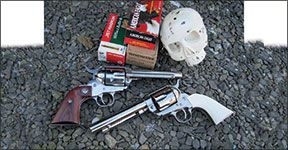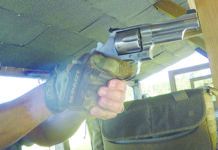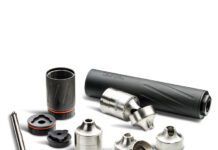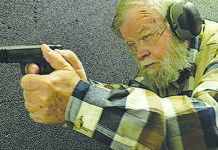Single-action-revolver purists cringe at the thought of a transfer bar in a six-shooter. The fact is, classic single actions are usually five-shooters rather than six-shooters. Reason: For safety, the loading regime for a classic single action is to load a chamber, skip a chamber, and load the rest, which allows the hammer to rest on the empty chamber. Some single actions have built-in transfer bars that are raised into firing position as the trigger is pulled to the rear. When the hammer falls in this design, it hits the transfer bar, which in turn transmits energy to the firing pin. Thus, these transfer-bar revolvers can be carried fully loaded without the risk of an discharge if the revolvers are accidentally dropped on their hammers. The ability to load six rounds appeals to plinkers, hunters, and home defenders, but to a Cowboy Action Shooting competitor, the advantage is moot — only five rounds are ever loaded at a time during CAS competition.

Accordingly, we evaluated two transfer-bar designs in 38 Special/357 Magnum chamberings more broadly than as pure competition guns. They were a Traditions Frontier Series 1873 Single Action Model No. SAT73-126, $609; and a Ruger New Vaquero No. 5108, $739. Here’s what our mild bunch encountered with these transfer-bar single-action revolvers.
Traditions Frontier Series 1873 Single ActionModel No. SAT73-126 38 Sp/357 Magnum, $609
The Traditions Frontier Series 1873 Single Action is a more classic single action than the Ruger in many ways. The Frontier uses the skinny trigger, had a grip that flared out, the ejector pivoted away from the barrel during shell extraction, and a flat main spring. The loading process differed with both revolvers. The Frontier requires the hammer be at half cock to rotate the cylinder but the loading gate could be opened with the hammer fully forward. On the Vaquero, only the loading gate needs to be opened for the cylinder to freely rotate. Those unaccustomed to single-action-Army design (SAA) found the Ruger more user friendly; those familiar with SAAs found the Traditions more to their liking. The Ruger had a slight advantage with one fewer step (not half-cocking the hammer) to load the gun. Testers found it was easy to load the Frontier once they had the process down.
The purists in the bunch seemed to gravitate to the Traditions Frontier. They liked the trigger and the flared out hog-leg grip. The grip was one piece of white PVC plastic that had a familiar feel in hand. The bottom edge of the grip, however, was sharp and cut a shooter who was firing 357 Magnum rounds. The problem was easily fixed with a file.
The timing was decent in the Frontier and in the Vaquero. There was no play in the cylinder on any of the chambers when the hammer was cocked and we tried to rotate the cylinder while the bolt was in the locking slot of the cylinder. A Brownells range rod was dropped down the barrel to determine chamber bore alignment. We did this when both revolvers were clean, as dirt can skew the test. There was no resistance to the rod passing from the barrel bore to each cylinder chamber. Both passed.
The finish was nicely executed, though there were some tool marks on the side of the trigger and in the frame just under the rear sight groove. One nit was the ugly rollmark on the top of the Frontier — Ruger hides its rollmark under the barrel — but this did not hinder performance. The front edges of the cylinder were chamfered, so holstering was easier. The serrations on the hammer were not as grippy or as neat as the ones on the Ruger, but there were no issues with a hammer slipping during cocking. Ham-fisted users found the cocked hammers of both revolvers bit into the web of their hands if their hands were high on the grip. This was more noticeable when firing the hotter 357 Magnum rounds and the pistols curled rearward in their hands. Many said they would take a file or Dremel tool to the edge of the hammer spur to make it less sharp. None said it was a show-stopper, it was just a trait of SAA revolvers. In a two-handed hold, the non-shooting hand could easily thumb back the hammer for fast shooting. With repeated firing, the barrel did heat up, so we appreciated that the ejector head of the Frontier rotated away from the barrel when it was needed to eject an empty case. The Ruger’s ejector head did not rotate, and shooters used caution not to burn the tip of their fingers on the hot barrel when they needed to use it.
The sights were shiny in bright sunlight, but these are not target pistols. One tester liked the shine, saying it was easier to see on a black target. Accuracy was acceptable with each gun, with the Ruger liking the ammunition selection slightly better than the Traditions. Shot one-handed or using two, the Traditions performed well. After repeated firing, there was no ring around the cylinder of the Frontier, nor did we get any lead splashed back due to a misaligned chamber. Likewise, we saw no splash of lead with the Ruger, though a faint ring could be seen. We didn’t clean the revolvers during testing, and with more than 300 rounds of all types of ammo through them, there was no binding of the cylinder. The two pistols were messy but they kept performing.
Ruger New Vaquero No. 510838 Sp/357 Mag, $739
Those accustomed to Ruger’s SAA revolvers, such as the Single-Six and Blackhawk, were at home with the New Vaquero. Many commented on the more slender, less chunky frame of the Vaquero compared to the Blackhawk. In hand, the Vaquero feels very different than a classic SAA. The trigger is wider, with a nice radius surface, and the grip is thin. Most liked the feel of the Ruger in hand. The purists on our team winced.
The Vaquero was bedecked in a glossy stainless steel finish that seemed to shine even in the dead of night. The sight did have glare in bright sun light, more than the front sight of the Frontier, we thought. The ejector rod housing was a different material, and the color did not match the rest of the revolver. The Vaquero was better finished than the Frontier, but that also was reflected in the Ruger’s higher cost. The bottom edge of the wood grip panels had a smidge too much sander time and could have been fitted a bit better, but that is really a nit.
The hammer of the Ruger took slightly more effort to cock than the Traditions. Most liked the wide trigger and felt they could press the trigger better. Though, when shooting at tombstone targets 15 yards away, precision was not really needed. Big-handed users had the same hammer-bite issue with magnum loads.
At 15 yards, both SAAs shot low of point of aim, but that did not seem to matter when we started knocking skulls around. An Impact Seal (doalloutdoors.com) Bonehead skull was used for fast shooting with both revolvers, using both a two-handed hold and one handed as well. The trick was to hit the skull, which we named Yorick, while it was moving. It was a challenge and, alas, both SAAs grew to know Yorick well. Both performed equally well, testers felt.
Our Team Said
l Traditions Frontier Series 1873 Single Action, Model No. SAT73-126 38 Sp/357 Magnum, $609. All agreed the transfer bar on both revolvers made the guns safer without complicating usability. The Frontier was favored by testers who preferred traditional SAAs. Most agreed either gun would be a keeper. The lower price of the Traditions’ gun was appealing.
l Ruger New Vaquero No. 5108 38 Sp/357 Magnum, $739. The New Vaquero was a good choice. Those new to SAAs thought it had a leg up on the Traditions. Both guns had nits we picked, but in the end, most testers would be happy with either revolver. The Ruger would get the nod if high-volume CAS-style shooting was on the agenda, even though it cost $140 more.
Written and photographed by Robert Sadowski, using evaluations from Gun Tests team testers. GT
traditionsfrontierseries1873.pdf























